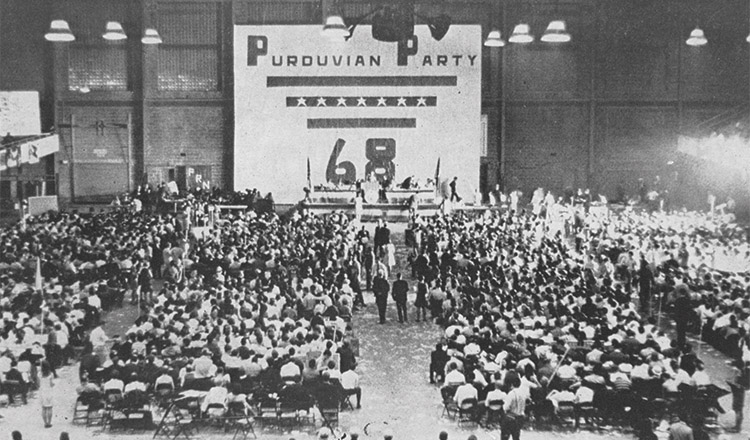Despite the fact that many students could not vote in federal elections in the 1950s and ’60s (the 26th Amendment, which lowered the voting age from 21 to 18, wasn’t ratified until 1971), Purdue was home to five mock national conventions during the two decades. Initially petitioned in 1935, it wasn’t until 1952 that the inaugural Purdue Mock Political Convention, often shorted to Mock P, took place. The goal of the quadrennial event was simple: to acquaint students with the policies, procedures, and activities of the national conventions; the implementation was a little more complex.
In 1951, three students and a faculty adviser formed the Purdue Mock Political Committee, which oversaw the formulation and execution of Mock P policies. An additional eight committees organized convention components such as public relations, state delegations, parades and rallies, and credentials. The committees’ first order of business was to name their party — One-Higher Party was initially chosen, but this shortly gave way to the Purduvian Party. The Purduvians were represented by different mascots over the years, including a penguin, a duck, and a shaggy dog named Demosthenes.
Drawing on the philosophies of the main political parties, the Purduvian Party developed nomination policies that were nonpartisan in support; the objective of Mock P was not to back favorite candidates but to correctly indicate, after having thoroughly studied the situation, the persons who would be elected president and vice president by the people of the United States. It was an exercise in the study of public policy — of political convictions and the will of the majority.
A year prior to Mock P, committees began organizing state delegations and rallies; enthusiastic students spent their summer breaks researching state attitudes on major issues. During the fall semester, campus housing units were each assigned a state to represent. Nationally prominent political figures and well-known speakers were called upon to visit campus for platform hearings, and newspaper subscriptions from around the country poured in so delegates could grasp political trends.
Over the course of a few days at the end of the spring semester, prior to the Republican and Democratic National Conventions, thousands of student delegates gathered in Lambert Fieldhouse to elect nominees for the United States presidential election. In keeping with the Purduvian Party’s motto — Political Prognosticators Par Excellence — the men who would lay claim to 1600 Pennsylvania Avenue were chosen correctly four times: Eisenhower in ’56, Kennedy in ’60, Johnson in ’64, and Nixon in ’68.

